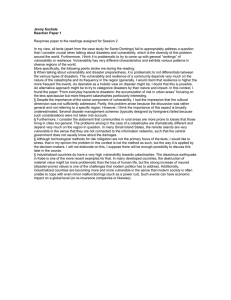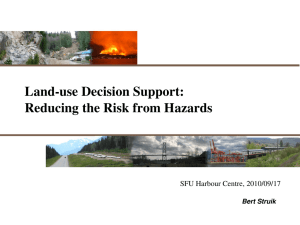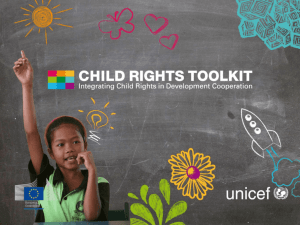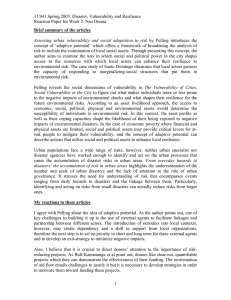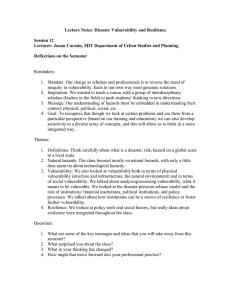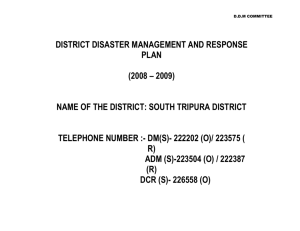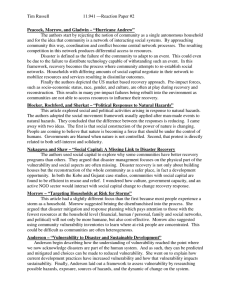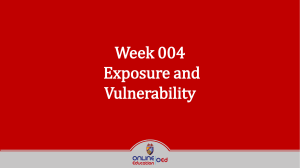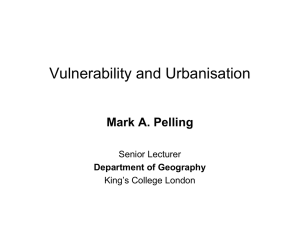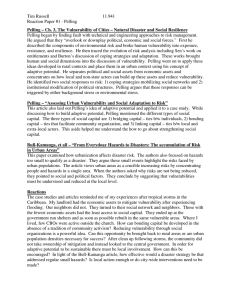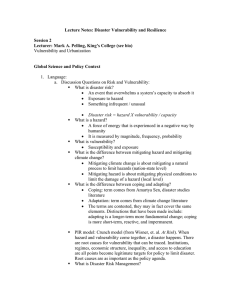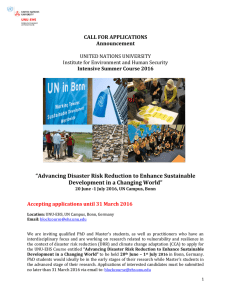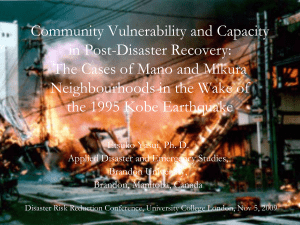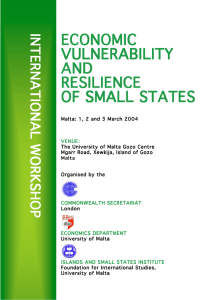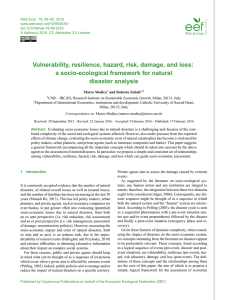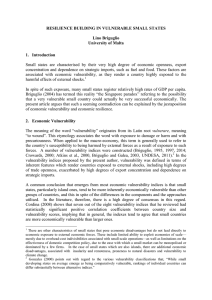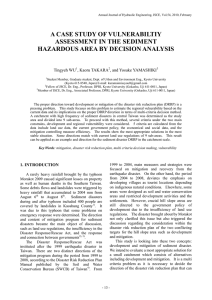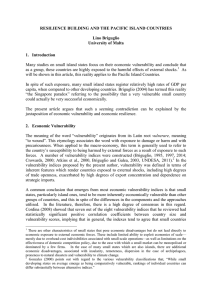Future Trends Series - GR:EEN Project
advertisement
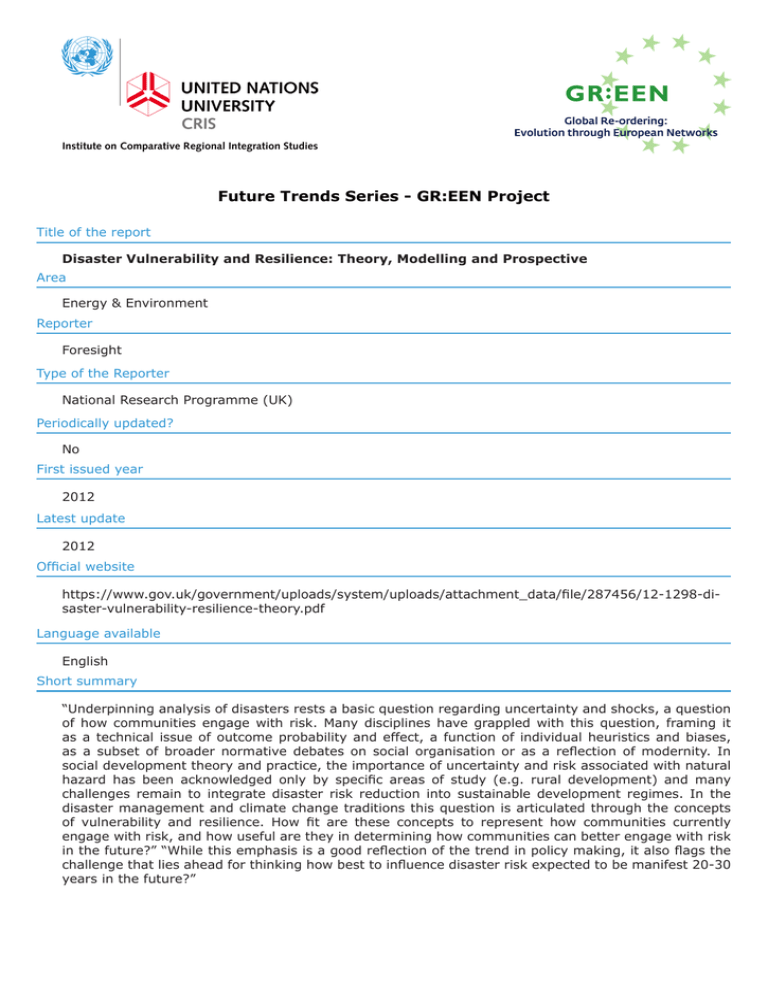
Future Trends Series - GR:EEN Project Title of the report Disaster Vulnerability and Resilience: Theory, Modelling and Prospective Area Energy & Environment Reporter Foresight Type of the Reporter National Research Programme (UK) Periodically updated? No First issued year 2012 Latest update 2012 Official website https://www.gov.uk/government/uploads/system/uploads/attachment_data/file/287456/12-1298-disaster-vulnerability-resilience-theory.pdf Language available English Short summary “Underpinning analysis of disasters rests a basic question regarding uncertainty and shocks, a question of how communities engage with risk. Many disciplines have grappled with this question, framing it as a technical issue of outcome probability and effect, a function of individual heuristics and biases, as a subset of broader normative debates on social organisation or as a reflection of modernity. In social development theory and practice, the importance of uncertainty and risk associated with natural hazard has been acknowledged only by specific areas of study (e.g. rural development) and many challenges remain to integrate disaster risk reduction into sustainable development regimes. In the disaster management and climate change traditions this question is articulated through the concepts of vulnerability and resilience. How fit are these concepts to represent how communities currently engage with risk, and how useful are they in determining how communities can better engage with risk in the future?” “While this emphasis is a good reflection of the trend in policy making, it also flags the challenge that lies ahead for thinking how best to influence disaster risk expected to be manifest 20-30 years in the future?” Key trends • “Strategic issues and public-function issues related to ‘societal demand pull’ are higher on the agenda than issues related to ‘technology or industrial pull’”; • “The technological fields most often mentioned in the foresight studies were ecology, energy, climate, health and ICT, and the trends most often mentioned were ecology, ageing society, innovation and knowledge society”; • “Trends related to culture, values and the experience economy have more attention in the foresight studies reviewed than in GTS2015. This difference may indicate uncertain drivers with respect to GTS but also drivers that may have a direct and significant influence on the direction of future developments”; • “(…) factors and aspects related to understanding culture and values require much more attention and awareness than they are receiving today.” • “Vulnerability is an expression of susceptibility to harm, and can also consider exposure to hazard. It asks us to consider the role of agency, social structures and environmental processes in determining those people and places most at risk”; • “While there are many ways of measuring and considering vulnerability, there is strong agreement that it is determined through the character of an object’s social, demographic, infrastructural, environmental, institutional, economic and cultural characteristics and underlying development and risk management trajectory”; • “Resilience is a mode of governance and encompasses resistance, persistence and transformation”; • “Unpacking pathways for resilience in disaster risk management places emphasis on deliberation and reflexivity in decision-making”; • “Reflexivity can be expressed, or constrained at all social levels from the individual to the international community. Understanding of reflexivity and policy actions towards it can be leveraged with research on social-learning and self-organisation”; • “Global dynamic pressures can be identified (and include conflict, demographic change, urbanisation, technological innovations, global environmental change, globalisation, economic shifts and political change). It is likely that these will interact, potentially in compounding ways, to emphasise existing inequalities in the distribution of vulnerability and capacity to choose risk management approaches that can contribute to more sustainable futures”; • “Development is fast becoming a project of risk management, rather than one of economic growth. This shifting emphasis rebalances notions of optimality and trade-offs between efficiency and redundancy. It can present a significant opportunity to reinvigorate the sustainable development agenda through the introduction of well developed (but till now largely marginalised) concepts, tools and practices. Closer relationships between climate change adaptation and disaster risk reduction has already demonstrated this potential and the possibility of a paradigm shift in development practice.” Suggestions / Methodology Research from primary sources and secondary and Modelling Reference to other trends reports? If yes, which reports? /

